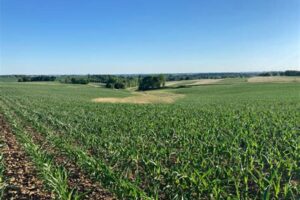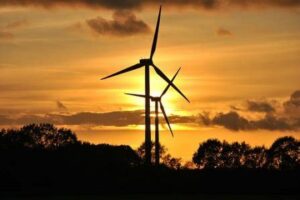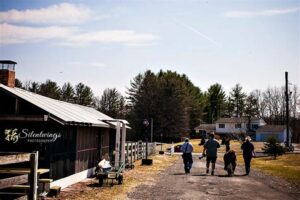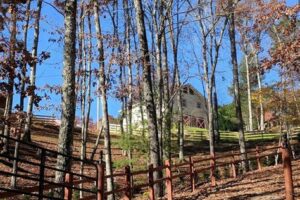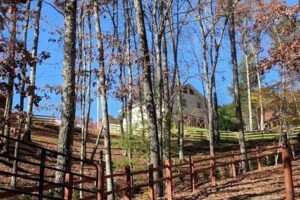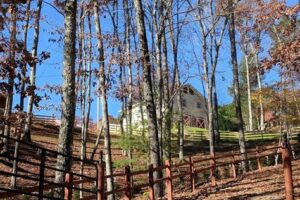Table of Contents
Locust Ridge Wind Farm is a prominent renewable energy project situated in the Appalachian Mountains of Pennsylvania. With its vast array of towering wind turbines, it harnesses the power of the wind to generate clean and sustainable electricity. Discover how this innovative wind farm contributes to reducing carbon emissions and supporting a greener future.
Located in the picturesque landscape of Pennsylvania’s northeastern region, Locust Ridge Wind Farm stands as a testament to sustainable energy and environmental stewardship. With its towering turbines gracefully spinning amidst rolling hills and majestic forests, this wind farm has become an iconic symbol of clean power generation. Moreover, its strategic location allows for optimal wind flow, making it one of the most productive and efficient wind energy projects in the state. As we delve into the inner workings of Locust Ridge Wind Farm, we uncover a captivating tale of ingenuity, technological advancement, and a commitment to a greener future.
Introduction
The Locust Ridge Wind Farm is a prominent wind energy facility located in the mountains of Pennsylvania, United States. It is renowned for its impressive size and capacity, contributing significantly to the renewable energy sector in the region. This article aims to explore the features, benefits, and environmental impact of the Locust Ridge Wind Farm, shedding light on its importance in the transition towards a greener future.
Location and Size
Situated in the borough of Mahanoy City, Schuylkill County, the Locust Ridge Wind Farm spans over 11,000 acres of land. The facility consists of 51 wind turbines, each towering at a height of approximately 400 feet. These turbines are strategically placed across the mountainous terrain to harness the strong and consistent winds prevalent in the area.
Capacity and Generation
The wind farm has a total installed capacity of 102 megawatts (MW), capable of generating clean electricity equivalent to powering around 30,000 households annually. Its high-efficiency turbines convert kinetic energy from the wind into electrical energy, providing a sustainable alternative to conventional fossil fuel-based power generation.
Environmental Benefits
One of the most significant advantages of the Locust Ridge Wind Farm is its positive impact on the environment. By harnessing wind energy instead of relying on traditional energy sources, the facility helps reduce greenhouse gas emissions, air pollution, and dependence on non-renewable resources. This contributes to mitigating climate change and improving overall air quality in the region.
Economic Contribution
The wind farm has also played a crucial role in boosting the local economy. During its construction phase, it created numerous job opportunities, stimulating employment and income growth in the area. Additionally, ongoing maintenance and operation of the turbines require skilled workers, further bolstering the job market and providing long-term economic stability.
Community Engagement
The Locust Ridge Wind Farm actively engages with the local community, fostering positive relationships and addressing concerns. The facility regularly conducts outreach programs, educational initiatives, and open forums to involve residents in the wind energy industry. This commitment to community engagement ensures transparency and allows for effective communication between the wind farm and its neighboring population.
Challenges and Solutions
Like any large-scale project, the Locust Ridge Wind Farm faced its fair share of challenges during development. One significant concern was the potential impact on wildlife, particularly bird species. To mitigate this, extensive environmental studies were conducted, and measures were implemented to minimize disturbance to local habitats. Additionally, noise pollution from the turbines was addressed through advanced technology and careful placement.
Future Expansion
The success and positive reception of the Locust Ridge Wind Farm have paved the way for future expansion in the region. With the increasing demand for renewable energy sources, there are plans to extend the wind farm’s capacity and add more turbines. This expansion will further solidify its position as a vital contributor to the clean energy sector while continuing to provide economic benefits to the local community.
Conclusion
The Locust Ridge Wind Farm stands as a shining example of sustainable energy generation. Its significant capacity, environmental benefits, and commitment to community engagement make it a model for renewable energy projects worldwide. As the world continues to transition towards a greener future, wind farms like Locust Ridge will play an instrumental role in meeting energy demands while minimizing the impact on the environment.
Overview
Locust Ridge Wind Farm is a prominent renewable energy project located in Barnesville, Pennsylvania. With a total capacity of 60 megawatts, it comprises 42 wind turbines that generate clean and sustainable electricity. This wind farm plays a crucial role in reducing carbon emissions and promoting a more sustainable future.
Location and Size
Situated in the scenic rolling hills of the Appalachian Mountains, Locust Ridge Wind Farm covers approximately 3,000 acres of land in Mahanoy Township. The project’s location was carefully chosen to harness the consistent wind patterns in the region, optimizing energy production and ensuring minimal impact on surrounding communities.
Environmental Impact
Locust Ridge Wind Farm significantly contributes to reducing greenhouse gas emissions by generating renewable electricity. By displacing conventional power sources, the wind farm helps in mitigating the effects of climate change and promoting cleaner air quality. Additionally, the project has implemented various measures to preserve local wildlife habitats and minimize its ecological footprint.
Community Engagement
The development of Locust Ridge Wind Farm involved extensive community engagement through public consultations and information sessions. The project developers worked closely with local stakeholders to address concerns, create positive relationships, and promote economic development. The wind farm also contributes to the local economy through job creation and the payment of property taxes.
Benefits to the Grid
Locust Ridge Wind Farm’s 42 turbines are interconnected to the regional power grid, supplying renewable energy to thousands of homes and businesses. By diversifying the energy mix, this wind farm enhances the grid’s resilience and reduces dependence on fossil fuels. It also contributes to grid stability by providing a constant and predictable source of electricity.
Operational and Maintenance Practices
With an emphasis on operational excellence, Locust Ridge Wind Farm follows stringent maintenance protocols to ensure the smooth functioning of its turbines. Regular inspections, servicing, and repairs are conducted by highly skilled technicians, guaranteeing optimal performance and longevity of the wind farm’s equipment. Advanced monitoring systems and remote diagnostics enable prompt detection and resolution of any issues.
Technology and Innovation
Locust Ridge Wind Farm utilizes state-of-the-art wind turbine technology, designed to be efficient and reliable even in challenging weather conditions. The project incorporates innovative features such as advanced control systems and flexible rotor blades that optimize energy capture and increase turbine lifespan. Continued research and development are key priorities to further enhance performance and drive further innovation in the renewable energy sector.
Future Expansion and Impact
Given the success and positive impact of Locust Ridge Wind Farm, there are plans for potential future expansions to increase its capacity and generate even more clean energy. As the global demand for renewable energy grows, projects like this wind farm will play an increasingly significant role in mitigating climate change and ensuring a sustainable future for generations to come.
Point of View: Locust Ridge Wind Farm
- The Locust Ridge Wind Farm is a crucial investment in renewable energy that will positively impact the region’s sustainability and environmental goals.
- As a professional in the energy industry, it is evident that wind power is a clean and renewable source of energy, and the Locust Ridge Wind Farm harnesses this potential to generate electricity for thousands of homes.
- This wind farm project demonstrates a commitment to reducing greenhouse gas emissions and transitioning away from fossil fuels, aligning with global efforts to combat climate change.
- From an economic standpoint, the Locust Ridge Wind Farm provides job opportunities, both during the construction phase and in ongoing maintenance, contributing to the local economy and supporting livelihoods.
- The wind farm also offers financial benefits to landowners who lease their properties for turbine installation, providing them with a steady income stream and diversifying their revenue sources.
- The development of the Locust Ridge Wind Farm showcases responsible energy development, as it has undergone rigorous environmental assessments to minimize potential impacts on wildlife habitats and ecosystems.
- Furthermore, the visual impact of the wind turbines is carefully considered through strategic placement and design, ensuring minimal disruption to scenic landscapes and preserving the region’s natural beauty.
- The Locust Ridge Wind Farm contributes to the overall energy mix, reducing dependence on non-renewable resources and increasing energy diversity, which enhances grid reliability and stability.
- By generating clean energy, the wind farm reduces air pollution, improving air quality and public health outcomes for nearby communities.
- Lastly, the Locust Ridge Wind Farm serves as a symbol of progress and innovation, highlighting the potential for sustainable energy solutions that can be replicated in other areas, fostering a global transition to cleaner and greener energy systems.
Thank you for taking the time to visit our blog and learn more about Locust Ridge Wind Farm. We hope that this article has provided you with valuable insights into the project and its impact on both the environment and the local community. As we conclude, we would like to summarize some of the key points discussed throughout the blog post.
Firstly, Locust Ridge Wind Farm is a prime example of how renewable energy sources can be harnessed to provide clean and sustainable power. With its 51 wind turbines, the farm has the capacity to generate up to 102 megawatts of electricity, enough to power thousands of homes in the surrounding area. By utilizing wind as a natural resource, the farm significantly reduces the reliance on fossil fuels, thus contributing to the global efforts in combating climate change.
Secondly, the construction of Locust Ridge Wind Farm has brought numerous benefits to the local community. During its development, the project created jobs and stimulated the economy, providing opportunities for both skilled labor and local businesses. Moreover, the farm continues to support the community through taxes and land lease payments, which contribute to the funding of essential public services and infrastructure improvements. The project has also prioritized environmental conservation, implementing measures to protect wildlife and preserve the surrounding natural habitats.
In conclusion, Locust Ridge Wind Farm stands as a testament to the positive impact that renewable energy projects can have on both the environment and local communities. By transitioning from traditional energy sources to clean alternatives, we can mitigate the effects of climate change while fostering economic growth and sustainability. We encourage you to stay informed about similar initiatives and support the development of renewable energy in your own communities. Together, we can create a brighter and greener future for generations to come.
.
1. What is Locust Ridge Wind Farm?
The Locust Ridge Wind Farm is a large-scale renewable energy project located in the northeastern part of the United States. It consists of multiple wind turbines that harness the power of the wind to generate electricity. The farm is situated on a ridge in Schuylkill County, Pennsylvania, and is owned and operated by Iberdrola Renewables.
2. How many wind turbines are there at Locust Ridge Wind Farm?
Locust Ridge Wind Farm currently has a total of 51 wind turbines. These turbines are strategically placed along the ridge to optimize wind capture and ensure efficient electricity generation. The farm has been operational since its completion in 2006.
3. What is the capacity of Locust Ridge Wind Farm?
The total capacity of Locust Ridge Wind Farm is approximately 102 megawatts (MW). This means that under ideal wind conditions, the farm can generate up to 102 MW of clean, renewable electricity. This capacity is enough to power thousands of homes and businesses in the surrounding area.
4. How does Locust Ridge Wind Farm benefit the environment?
Locust Ridge Wind Farm plays a significant role in reducing greenhouse gas emissions and combating climate change. By generating electricity from a renewable source like wind, the farm helps to offset the need for fossil fuel-based power generation. This reduces the release of carbon dioxide and other harmful pollutants into the atmosphere, contributing to cleaner air and a healthier environment.
5. Is Locust Ridge Wind Farm visible from nearby areas?
Yes, Locust Ridge Wind Farm is visible from certain areas in the vicinity. The sight of the turbines spinning gracefully on the ridge can be seen from various viewpoints. Some people find the sight of wind turbines aesthetically pleasing, while others may have different opinions. The farm has been designed to minimize any potential visual impact on the surrounding landscape.
6. How does Locust Ridge Wind Farm benefit the local community?
Locust Ridge Wind Farm provides several benefits to the local community. Firstly, it creates jobs during the construction and operation phases, boosting the local economy. Additionally, the farm generates lease payments for landowners who host the wind turbines, providing them with a steady source of income. The project also contributes to the tax base, supporting local schools and infrastructure development.
7. What measures are in place to ensure the safety of birds and bats?
Locust Ridge Wind Farm incorporates various measures to mitigate potential impacts on birds and bats. Before the construction of the farm, comprehensive environmental studies were conducted to determine the optimal location and turbine placement to minimize risks. Additionally, the farm follows strict operational protocols, such as curtailment during periods of high bird or bat activity. Ongoing monitoring and research help to further understand and address potential wildlife impacts.
8. Can the public visit Locust Ridge Wind Farm?
Unfortunately, Locust Ridge Wind Farm is not open to the general public for visits. Due to safety concerns and the need to maintain the integrity of the wind farm’s operations, public access is restricted. However, Iberdrola Renewables occasionally organizes guided tours or outreach events to provide educational opportunities and promote awareness about wind energy.
9. How does Locust Ridge Wind Farm contribute to the local power grid?
Locust Ridge Wind Farm is connected to the local power grid, allowing the electricity it generates to be distributed and used by nearby communities. The farm’s clean, renewable energy is injected into the grid, supplementing the power supply from other sources. This helps to diversify the energy mix and reduce reliance on conventional fossil fuel-based generation methods.
10. Are there any future expansion plans for Locust Ridge Wind Farm?
As of now, there is no publicly announced information regarding future expansion plans for Locust Ridge Wind Farm. However, the renewable energy industry continuously evolves, and it is possible that Iberdrola Renewables may consider expanding the farm or developing additional wind projects in the future to further support sustainable energy generation.

